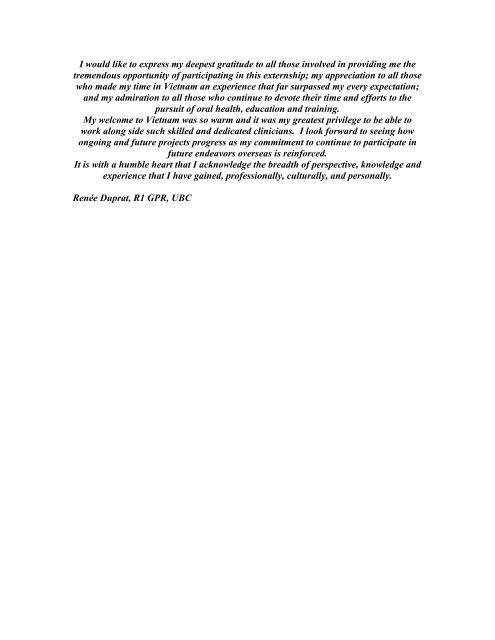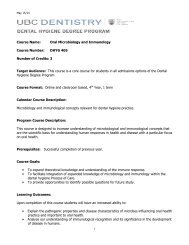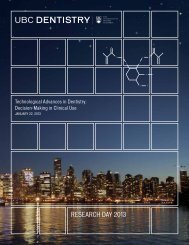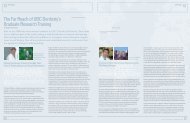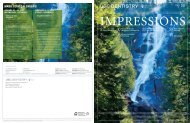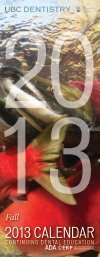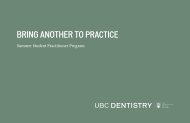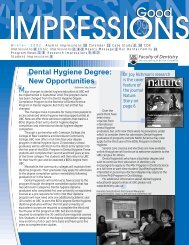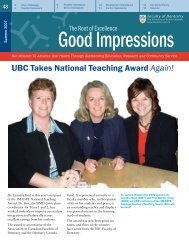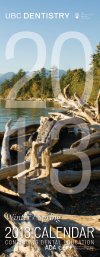I would like to express my deepest gratitude to all ... - UBC Dentistry
I would like to express my deepest gratitude to all ... - UBC Dentistry
I would like to express my deepest gratitude to all ... - UBC Dentistry
- No tags were found...
You also want an ePaper? Increase the reach of your titles
YUMPU automatically turns print PDFs into web optimized ePapers that Google loves.
I <strong>would</strong> <strong>like</strong> <strong>to</strong> <strong>express</strong> <strong>my</strong> <strong>deepest</strong> <strong>gratitude</strong> <strong>to</strong> <strong>all</strong> those involved in providing me thetremendous opportunity of participating in this externship; <strong>my</strong> appreciation <strong>to</strong> <strong>all</strong> thosewho made <strong>my</strong> time in Vietnam an experience that far surpassed <strong>my</strong> every expectation;and <strong>my</strong> admiration <strong>to</strong> <strong>all</strong> those who continue <strong>to</strong> devote their time and efforts <strong>to</strong> thepursuit of oral health, education and training.My welcome <strong>to</strong> Vietnam was so warm and it was <strong>my</strong> greatest privilege <strong>to</strong> be able <strong>to</strong>work along side such skilled and dedicated clinicians. I look forward <strong>to</strong> seeing howongoing and future projects progress as <strong>my</strong> commitment <strong>to</strong> continue <strong>to</strong> participate infuture endeavors overseas is reinforced.It is with a humble heart that I acknowledge the breadth of perspective, knowledge andexperience that I have gained, profession<strong>all</strong>y, cultur<strong>all</strong>y, and person<strong>all</strong>y.Renée Duprat, R1 GPR, <strong>UBC</strong>
Vietnam Externship:VIETNAM OUTCOMES ASSESSMENTNovember 2003Renée Duprat, BSc, DMDThis dental residency externship is a collaborative effort by the University of Ho ChiMinh City, Institute of Odon<strong>to</strong>-S<strong>to</strong>ma<strong>to</strong>logy of HCMC, Cancer Center of HCMC, and theUniversity of British-Columbia.Educational Objectives:1. To learn about different ways of health care provision, specific<strong>all</strong>y oral health care, ina developing country.2. To expand on the scope of familiarity with various disease processes and traumaticinjuries involving the head and neck especi<strong>all</strong>y with respect <strong>to</strong> pathologies of highprevalence in Asian populations.3. To gain knowledge regarding different cultural beliefs and behaviors in general, andspecific <strong>to</strong> health care, and <strong>to</strong> be able <strong>to</strong> apply this heightened level of understanding<strong>to</strong> the large multicultural population of Canada.4. To offer educational reciprocity as well as possible aid <strong>to</strong> improve the provision oforal health care in the Vietnamese population.5. To foster educational and research development that can be mutu<strong>all</strong>y beneficial <strong>to</strong>Vietnam and Canada.Resident Requirements:1. Residents will show a slide presentation during their rotation on a specific area ofHospital <strong>Dentistry</strong> at the University of Ho Chi Minh City.2. Residents will present THREE case studies with pho<strong>to</strong>graphs <strong>to</strong> the <strong>UBC</strong> Faculty.3. Residents will complete an Outcomes Assessment for the rotation in Vietnamincluding a Needs Assessment of areas requiring aid at the various institutions.Rotation Parameters:The rotation is 3 weeks in duration and <strong>to</strong>ok place in Ho Chi Minh City, which is themajor center of southern Vietnam. In general, two different GPRs will participate duringthe months of November and March of the residency year.An additional one-week elective may be taken <strong>to</strong> perform charity pediatric dental servicesin Danang, in central Vietnam.
The core program consists of a standard working week Monday through Friday, withtime spent at the Cancer Center of HCMC and the Institute of Odon<strong>to</strong>-S<strong>to</strong>ma<strong>to</strong>logy.Some time will also be spent at the University of Ho Chi Minh City, Faculty of Odon<strong>to</strong>-S<strong>to</strong>ma<strong>to</strong>logy._____________________________________________________Institute of Odon<strong>to</strong>-S<strong>to</strong>ma<strong>to</strong>logy201A Nguyen Chi Tranh, Q5Ho Chi Minh City, VietnamTel: 855 6732 (Chi Ngan), 855 3698Fax: 848 – 855 1394Direc<strong>to</strong>r Dr. Lam PhuongThis hospital is the national hospital of HCMC and includes both outpatient and inpatientcomponents. The outpatient building deals with <strong>all</strong> aspects of comprehensive dental careincluding oral diagnosis, oral medicine, res<strong>to</strong>rative, oral surgery, periodontics andimplan<strong>to</strong>logy. The resident’s involvement is mainly with the inpatient component, whichserves as one of the major head and neck surgical hospitals in southern Vietnam. Thisfacility sees large numbers of head and neck traumas due in large part <strong>to</strong> the vast majorityof mo<strong>to</strong>rcyclists and their lack of protective headgear. Furthermore, <strong>all</strong> aspects of headand neck surgery are undertaken in the three operating rooms including tumor and cystresections, temporomandibular joint surgery, orthognathic surgery, correction ofcraniofacial deformities and cleft lip and palate repair. On average, 12 <strong>to</strong> 13 patients aretreated daily. The hours of operation are from 7am <strong>to</strong> 4pm. Most surgeons can speaksome English or French in addition <strong>to</strong> their native Vietnamese. At the Institute, residentswill have an opportunity <strong>to</strong> observe and provide assistance whenever possible.Procedures <strong>to</strong> be observed/assisted at the Institute of Odon<strong>to</strong>-S<strong>to</strong>ma<strong>to</strong>logy:1. Cleft lip and palate repair2. Temporomandibular joint surgery3. Repair of the following fractures:• Zygomatic arch• Subcondylar• Angle• Symphysis• Lefort 1, 2 and 34. Resection of cysts and tumors5. Wisdom teeth extractionActivities at the Institute of Odon<strong>to</strong>-S<strong>to</strong>ma<strong>to</strong>logy:1. Surgical assist of head and neck surgery with Dr. Lam Phuong, Direc<strong>to</strong>r of OMFS. Ihad the pleasure of being present for the Institutes first mandibular advancement viasagittal split technique for correction of class II malocclusion. Other procedures
included a large majority of subcondylar, symphyseal and zygomatic fracturessecondary <strong>to</strong> mo<strong>to</strong>rcycle trauma in addition <strong>to</strong> parotid and other tumor resections.2. Participation in US Mission Operation Smile including screening of over 150 localand rural children and with varying degrees of complicated cleft lip and palate,craniofacial deformities, severe burns requiring scar revision, NOMA and othercommon and not so common lesions/infections. Over 100 patients were accepted andreceived surgical treatment over a period of 4 days. Many will require further phasesof surgical correction and will return <strong>to</strong> HCMC from great distances <strong>to</strong> attend the nextmission. Operation Smile coordinates approximately 8 local missions at the Instituteof Odon<strong>to</strong>-S<strong>to</strong>ma<strong>to</strong>logy per year in addition <strong>to</strong> 2-3 national missions, the last ofwhich was in Lao province.3. Morning grand rounds with OMFS residents III and IV. New admissions werediscussed with review of case his<strong>to</strong>ry, films and surgical treatment plan. Patients onthe ward are separated in<strong>to</strong> 1 of 5 bays by sex and treatment modality required with 2-3 patients commonly per bed.4. One day spent in the Oral Diagnosis department as the first point of entry for <strong>all</strong>patients. Here, a variety of facial cellulitises, cysts, tumors, lesions, fractures andorofacial pain are screened and triaged for treatment. Drainage of large facialabscesses, needle biopsies and IMF removal are routinely performed in this setting.5. Meeting with Dr. Ngo Khanh, Vice Direc<strong>to</strong>r of the Faculty of Odon<strong>to</strong>s<strong>to</strong>ma<strong>to</strong>logyand Chairman of the Dental Public Health Department regarding information on oraldisease in Vietnam and dentistry demographics in Canada.6. Documentation of specific head and neck cancer, pathology and surgical cases fromboth the HCMC Cancer Center and the Institute of Odon<strong>to</strong>-S<strong>to</strong>ma<strong>to</strong>logy forpresentation purposes at <strong>UBC</strong>.Needs assessment of the Institute of Odon<strong>to</strong>-S<strong>to</strong>ma<strong>to</strong>logy:1. Additional OR space_____________________________________________________Ho Chi Minh City Cancer Center3 No Trang Long, Binh ThanhHo Chi Minh City, VietnamDirec<strong>to</strong>r Dr. Nguyen HongThis cancer center serves as the main cancer center for treatment of patients from thesouthern half of Vietnam. Head and neck cancers are diagnosed via CT, MRI, ultrasound,biopsy and radiography. This facility is capable of providing major treatment modalitiesof surgical resection, radiation and chemotherapy for the treatment of malignancies.Children from an overflowing pediatric ward are now also receiving chemotherapy for avariety of malignancies. The center continues <strong>to</strong> receive approximately 30 new head andneck cancer admissions per week. Patients travel from local and rural areas and stay incrowded wards, often 2 <strong>to</strong> 3 per bed, categorized by sex and location of their tumor, with
waits of up <strong>to</strong> 4 weeks for surgery and radiation therapy typical. Radiation is deliveredvia the center’s three cobalt radiation machines. Interstitial radiation of localized tumorsis also provided at this center via the placement of radium needles.Due <strong>to</strong> the high dose radiation pro<strong>to</strong>cols for treatment of a vast majority of advancedcancers (most receive a standard 6600cGy/33#), a relatively high incidence of ORNoccurs (15% for head and neck cancers and >50% for relapsed cases of patients havinginitial brachyradiation therapy and subsequent Cobalt radiation). The fac<strong>to</strong>rs whichcontinue <strong>to</strong> result in a relatively high mortality and morbidity rate for head and neckcancer patients include:• Advanced stages of tumors due <strong>to</strong> lack of regular medical/dental visits madeby patients as a result of fear, restricted access <strong>to</strong> services, lack of funds, lackof public awareness and education.• Lack of standardized early detection measures (head and neck exam, <strong>to</strong>luidineblue staining).• Lack of post-treatment follow-up for potential oral complications uponcompletion of radiation therapy.• Lack of facilities and personnel <strong>to</strong> keep up with the number of head and neckcancer patients requiring treatment.• High levels of scatter radiation with limited immobilization and shieldingtechniques.There is one full time dentist on staff, however, his duties extend more <strong>to</strong> endoscopy andradiology than <strong>to</strong> clinical dentistry. Otherwise, the hospital dental clinic is, for the mostpart, staffed by volunteer new dentists who are committed <strong>to</strong> 3 years of manda<strong>to</strong>ry parttime government service in order <strong>to</strong> be eligible <strong>to</strong> open their own practice. Pre, mid andpost cancer treatment pro<strong>to</strong>cols are in place however somewhat ill defined at this timewith a lack of standardization. On average 12 <strong>to</strong> 13 patients are seen per day with hoursof operation 8:30am <strong>to</strong> 3:30pm. Most dentists can speak some English or French inaddition <strong>to</strong> their native Vietnamese. At the cancer center, residents will have theopportunity <strong>to</strong> interact at <strong>all</strong> levels of the health care team and provide basic dentaltreatment, mostly pre, with some mid and post cancer treatment.Procedures <strong>to</strong> be observed/assisted at the Ho Chi Minh City Cancer Center:1. Weekly grand rounds of patient on the surgical ward.2. Endoscopy of patients for evaluation of oropharyngeal and nasopharyngeal cancers.3. Observation of CT examination and diagnosis.4. Observation of the radiation facilities.5. The placement of platinum coated radium needles in localized tumors.6. Surgical resection of benign and malignant tumors from the head and neck:• Skin, salivary glands, thyroid, parathyroid, nasopharyngeal, laryngeal,maxillary, mandibular, oral and neck dissections.
Activities at the Ho Chi Minh City Cancer Center:1. Setting up the dental clinic for the Head and Neck cancer ward. Panorex films arebeing supplied by neighboring facilities and have been incorporated as standard preradiationassessment pro<strong>to</strong>col. Capacity exists for exposure and hand development ofsupplemental periapical views. Donations of a cavitron, scaling instruments and<strong>to</strong>othbrushes have made provisions of oral hygiene and oral hygiene instructionpossible. The latter however is limited and has been identified as a major focus in thedevelopment of oral health promotion. Newly acquired au<strong>to</strong>clave remains unusedand outside of heat sterilization of instruments, issues of surface disinfection, crosscontaminationand cross-infection remain. Time was spent explainingrecommendations for and demonstrating infection control techniques.2. Continued with development of Needs Analysis and Pre-radiation Oral Assessmentsof new Head and Neck cancer admissions. Since November 2002, approximately 650assessments have been completed with the help and direction of Dr. Hong (Head ofPathology, University of HCMC). Data from 450 patients has been brought back <strong>to</strong>Canada and submitted for statistical analysis.3. Need identified and progress made <strong>to</strong>wards development of a standardized treatmentpro<strong>to</strong>col for pre-radiation head and neck cancer patients. Discussions with Dr.Andrew Tsang and Dr. Michelle Williams will continue <strong>to</strong> this effect for developmen<strong>to</strong>f a ‘draft’ pro<strong>to</strong>col, cus<strong>to</strong>mized for this particular population, by April 2004.4. Dental treatment of pre-radiation patients in the Head and Neck cancer ward isongoing with treatment limited <strong>to</strong> exodontia of compromised dentition in the field ofradiation and atraumatic res<strong>to</strong>rative treatment of remaining dentition.5. Samples of Biotene gum, <strong>to</strong>oth paste and alcohol-free antibacterial mouthrinse,Oralbalance, Mouthkote and Moistir mouth lubricants, Neutragel and Oro-minremineralizing gels, Benzydamine and Oral-B fluoride rinses, Prevident 5000 andSensodyne <strong>to</strong>oth pastes provided with ingredient lists for duplication. Donations ofamalgam, composite, anaesthetic and sutures were provided by VGH.6. Grand rounds of patients waiting for head and neck surgery with review of casehis<strong>to</strong>ry, relevant pathology and imaging. This included a visit <strong>to</strong> the overflowingpediatric ward facilitated by the Pediatric Direc<strong>to</strong>r Dr. Tran Khuong.7. Observed the radiation facilities whereby treatment is delivered in one of three Cobaltradiation rooms, with only lead blocks <strong>to</strong> assist in limiting scatter radiation and noimmobilization of the patient during the procedure.8. Meeting with Dr. Tran Anh Tuong who is currently conducting research on theincidence of Osteoradionecrosis and has collected data on 30 patients <strong>to</strong> date. Casesof mild, moderate and severe ORN were presented and reviewed with discussions<strong>to</strong>wards sharing of information regarding Canadian guidelines and pro<strong>to</strong>cols forHyperbaric Oxygen therapy. There are now three centers for HBO therapy inVietnam however treatment remains limited <strong>to</strong> those who can afford it(US$100.00/20 dives of 90 minutes) and tends <strong>to</strong> be delivered after surgicalintervention. Resident experts are limited.
9. Documentation of specific head and neck cancer, pathology and surgical cases fromboth the HCMC Cancer Center and the Institute of Odon<strong>to</strong>-S<strong>to</strong>ma<strong>to</strong>logy forpresentation purposes at <strong>UBC</strong>.Needs assessment of the Ho Chi Minh City Cancer Center:1. More consistent oral hard and soft tissue examination and charting.2. Patient education with respect <strong>to</strong> oral hygiene instructions, potential post-radiationcomplications and management. Visual aids such as posters, pamphlets, videos anddemonstrations <strong>to</strong> be incorporated as a standard.3. Continuing education for staff and volunteers with respect <strong>to</strong> oral health promotionand counseling of this particular patient population.4. Continuing education for the rural dental community with regards <strong>to</strong> early detectionof head and neck cancers.5. Incorporation of infection control principles in an effort <strong>to</strong> limit cross-contaminationand cross-infection.6. Standardization of pro<strong>to</strong>cols for provision of most effective dental care <strong>to</strong> a variety ofhead and neck cancer patients depending on their staging and the treatment <strong>to</strong> bereceived. Criteria <strong>to</strong> determine which teeth should be extracted prior <strong>to</strong> radiationtherapy in an effort <strong>to</strong> prevent potential complications of radiation treatment andfacilitate post-radiation management (fluoride application, diet modification,p<strong>all</strong>iative adjuvants, etc.)7. Mid and post cancer treatment oral assessment follow-up and rec<strong>all</strong>.8. Dental equipment/supplies (Surgical handpiece and improved suction capacity).9. Continue <strong>to</strong> establish the role of hospital dentistry as an important part of themanagement of Head and Neck cancer patients before, during and after radiationtherapy <strong>to</strong> reduce potential post-radiation treatment oral complications.10. Establish a presence in the pediatric ward at the level of prevention and OHI.11. Orofacial pain control and p<strong>all</strong>iative care via pharmacotherapy pro<strong>to</strong>col and provisionof affordable, homemade alternatives.12. Improve radiation shielding and immobilization technique and facilities.13. Facilitate sharing of resource material on ORN and development of HBO pro<strong>to</strong>cols.14. Further training and development of key Vietnamese caregivers in Hospital <strong>Dentistry</strong>.15. Research:• Epidemiological studies regarding incidence, morbidity and mortality ofORN.• Ongoing epidemiological studies regarding pre-radiation oral assessmentswith intentions of standardized pro<strong>to</strong>col development and implementation.• Studies regarding feasibility and outcome of widespread fluoride varnishapplication for caries prevention post-radiation.16. Long-term:• Linear accelera<strong>to</strong>r with shielding and immobilization.• Hyperbaric Oxygen therapy as a standard prior <strong>to</strong> surgery of irradiatedpatients.• Expansion of the facility.
• Hiring of full time dental personnel (dentist, hygienist, assistant) <strong>to</strong> aid inprovision of treatment <strong>to</strong> a large number of patients, supervision andconsistency.• Facial prosthetics training and facilities._____________________________________________________Faculty of Odon<strong>to</strong>-S<strong>to</strong>ma<strong>to</strong>logy, University of HCMC652 Nguyen Trai, Q5Ho Chi Minh City, VietnamVice Dean Dr. Huynh Anh LanThe Faculty of Odon<strong>to</strong>-S<strong>to</strong>ma<strong>to</strong>logy is the largest teaching institution of Vietnamesedental education and now provides training for <strong>all</strong> dental career options. Undergraduate,predoc<strong>to</strong>rate and postgraduate programs are available with curriculum developmentunderway for dental hygiene and labora<strong>to</strong>ry technology training. Approximately 80-100new students are accepted each year for the six-year undergraduate program. The facultyis active in the provision of clinical service <strong>to</strong> the public, community outreach and oralhealth promotion in addition <strong>to</strong> continuing education of dental practitioners.Furthermore, both regional and international research projects are ongoing with mostrecent efforts directed <strong>to</strong>wards a survey of the oral health of drug addicted and HIVinfected population of HCMC.Activities at the Faculty of Odon<strong>to</strong>-S<strong>to</strong>ma<strong>to</strong>logy:1. Presented a PowerPoint presentation of “Oral Complications of Chemotherapy andtheir Management”. As this modality of treatment is now being implemented in thepediatric population at the HCMC Cancer Center, guidelines for management of thisparticular subset were provided in addition <strong>to</strong> BCCA guidelines for adult patients.2. Tour of faculty and student clinics facilitated by Vice Dean Dr. Anh Lan.3. Meeting with Dr. Anh Lan, Dr. Nguyen Hong, Dr. Andrew Tsang, Dr. Chris Zed,Sherry Priebe and many of the volunteer dentists from the HCMC Cancer Center <strong>to</strong>discuss any concerns with regards <strong>to</strong> current hospital program and/or suggestions forimproved efficiency. Issues of oral health promotion, oral hygiene instruction, patientcounseling with regards <strong>to</strong> potential complications of treatment and theirmanagement, and standardization of treatment pro<strong>to</strong>cols specific <strong>to</strong> the Vietnamesepopulation, were brought up. Suggestions with regards <strong>to</strong> introducing a DentalHygiene rotation at the Center, developing patient education materials and practices,and implementing a draft treatment pro<strong>to</strong>col were addressed favorably.


